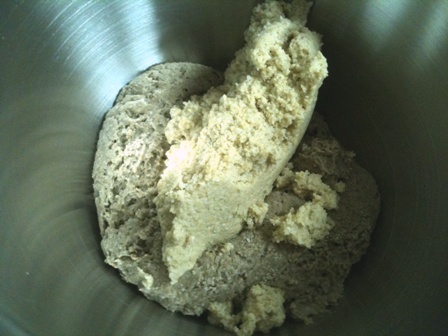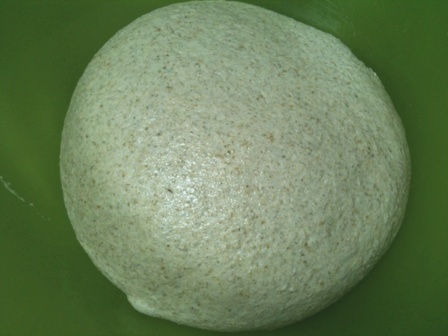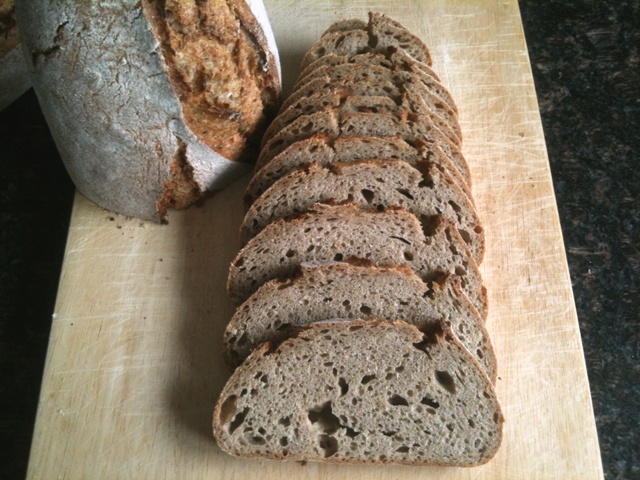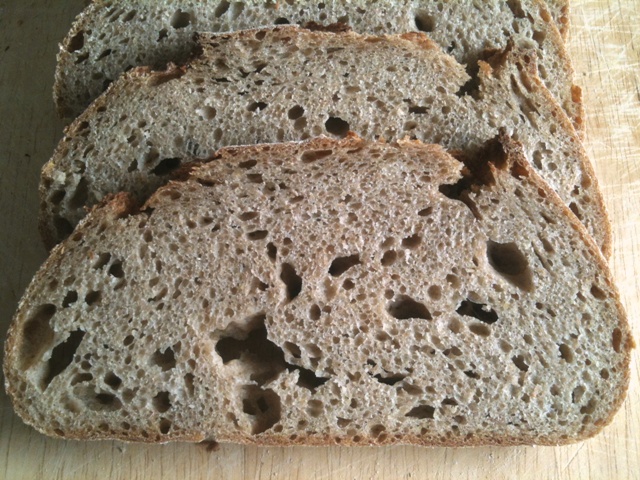
Rye Sourdough with Spelt and soaker

Last week, I had some left over whole spelt flour, some corn meal, and some semolina in addition to a ripe Rye starter. Therefore, I decided to put them all to use in a new recipe as follows:
UPDATE** INSTRUCTIONS:
Prepare the Rye sour by adding a tablespoon and a half of your active rye starter to the 250g water, and mix well to disperse. Add the Whole rye flour, mix well, and let stand for 8-12 hours at room temperature until the surface just starts to crack and collapse. To prepare the soaker, weigh all soaker ingredients into a bowl, and then weigh 160 grm of water, boil it, and add it to the soaker. Mix well, cover, and let stand until overnight, or when your rye sour is ready.
Next day, mix all ingredients at once, by hand or using a mixer for 5-10 minutes. The dough will remain relatively sticky, so try to resist adding any flour at this stage.Shape as a round and let ferment in an oiled bowl for 2 hours at preferably 78 F or 24-25C, folding it half way through at the 1 hour mark. By the end of bulk fermentation, the dough will have risen by 50-60%. scrape your dough onto a heavily floured surface, pat the dough even (Don't knead), divide into the desired dough pieces, and round each piece leaving them to rest for 15- 20 min, covered. Dust your basket with a mixture of all purpose flour and rice flour, and shape your dough and invert it smooth side down into the basket. The final fermentation will be only 45 minutes, but watch the dough NOT the clock. Preheat your oven at this stage with a stone in place to a 500F or 260C. 5 minutes before loading the bread, place your steaming dish filled with wet towels on the bottom of your oven. When ready, invert the dough on baking paper lined peel/ board and close the oven immediately. Bake for 15 minutes with steam, and then remove the steaming dish and reduce the temperature to 400F for another 20-25 minutes.
When the time is over, remove your bread from the oven. Wear oven mitts, and tap on the bottom of one loaf, It should sound hollow. Furthermore, you may insert a thermal probe into the center of the loaf from the bottom, and the temperature should register 195-200F or 90-95C. If it doesn't, put it back in the oven for another 10 minutes. Cool the bread completely on a wire rack, prior to cutting.





Due to the soaker, the aroma of this bread is really attractive. When cool, The crust was somewhat chewy, and the crumb slightly moist but not chewy. The flavor of this bread is earthy sweet and very pleasant. The crumb is close textured and compact due to all the whole grains, the bread might have benefited from extra lightness by increasing bread/all purpose flour.
I have eaten this bread thinly sliced with a spread of cheese, and it was fabulous. This bread keeps really well.
- Khalid


Comments
You go girl!
Hello Khaled..I made this bread today yet got a little dense crumb...I substituted the 50g rye with spelt..as for bulk I did one hour room temperature with one fold after the hour, then in the fridge around 8 hours since it was 1 am :(..in the morning the dough was nicely proofed and not collapsed..cut preshaped and 20 minutes later I shaped into two boules..the first loaf left it over an hour, did the poke test and was satisfied yet dense crumb although tastes beautiful..still waiting on the second one to cool but it rested another hour I guess at room temperature...I guess I used to all rye bread so I know when ready, or wheat bread..yet not sure I can tell when the loaf is ready for the oven in final proof..How to check? thanks in advance for your time
Hello, and thanks for trying the recipe. It could be a challenge to tell when a dough of wheat is proofed and ready to be baked. practice should be your guide. Ideally, you have to look for a soft slightly pillowy (pillow -like) feel to the dough, and not tight and springy.
from your description on the density of the loaf, i can tell that either the bread flour is weaker than it should, or you have not kneaded it /folded it enough. It could also be due to the fact that you've only allowed it to rest for 20 minutes. A cold dough needs to rest for a longer period of time. I'd shoot for 1 hour.
i hope this Helps!
best wishes,
khaled
Hello, in bulk fermentation and proofing what am I to look for? just the increase in size? since I tried the pocking technique and I do not think that it is accurate in such a bread since from the first hour of fermentation the indentation did not bounce back
Thank you Khaled
Keeping to the spirit if not the letter of the formula, I used substitutions based on what was in the pantry: : coarse whole rye flour (pumpernickel) for the whole rye flour, whole wheat flour for the whole spelt, and buckwheat groats for the semolina in the soaker. And a little extra water because the dough looked as if it needed it.
The crumb is more open than I expected from nearly 60% whole grains (counting the soaker) at 75% hydration (counting the soaker).
The flavor is pretty mild, but pleasant. The combination of whole grains means that none of them stand out particularly but they all combine in a nice way. I'm surprised that the buckshot pellets of buckwheat groats in the soaker just melted away, adding their mild flavor, plus nutrients and fiber, to the bread.
The pumpernickel makes the grain a little more coarse, in a nice way.
Sourdough Rye w/Multigrain Soaker Photos
Pages